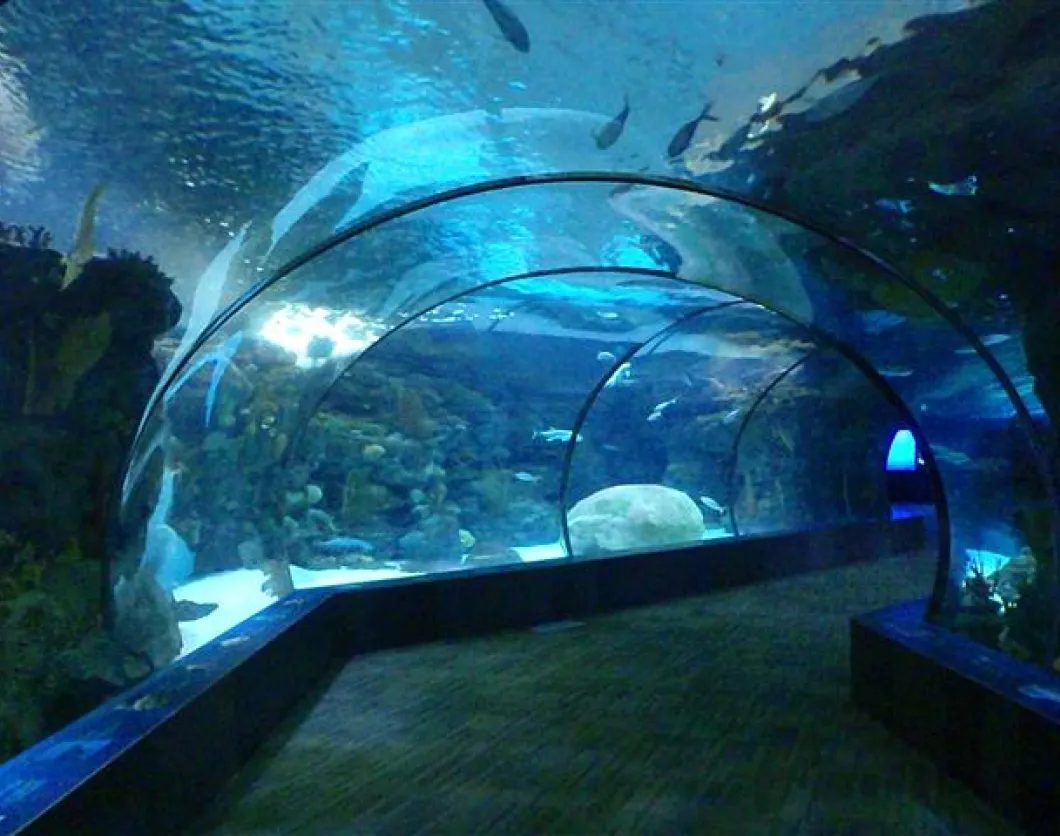The Henry Doorly Zoo in Omaha attracts over a million visitors a year. Starting off as mall Riverview Park zoo, established in 1894, the zoo has made itself into a huge success and a great leader in environmental awareness and education. Included in the zoo is a live indoor tropical rainforest called the Lied Jungle and a huge aquarium called the Scott Aquarium. It has the largest indoor desert in the world and is notable for housing the largest cat complex in North America. It is home to 962 different species of animals
The zoo is famous for its breeding of endangered species and exotic animals. A steam-powered locomotive circles around the 130 acre park, so that if you get tired looking at all of the exhibits, you don't have to walk all the way back.
The Lied Jungle includes three separate geographical zones, Asia, Africa, and South America. Visitors get to experience all the effects of being in the rainforest all indoors. As you wander through the rainforest, you pass streams and waterfalls and can even go up into the treetops to actually experience what the prime apes and birds do.
The Scott Aquarium is over 72,000 square feet large. The glass tunnel part alone holds 850,000 gallons of water. Sharks, Rays, and even Penguins inhabit and greet the guests.
The Aviary is the main attraction at the zoo bypassing all of the other exhibits. It's free-flight and has an elevated walkway and as you walk in, you are greeted by more than 500 different exotic species of bird. The aviary is the second largest in the world.
Initially, about 500 birds from all parts of the world occupied the area, including some 50 flamingos. Half of the birds require indoor shelter during the winter. A shelter under the center gazebo provides winter quarters for the flamingos and ibises. Approximately 14 feeding stations are located throughout the aviary. While species may be periodically added, care is taken to maintain individual niches and to minimize niche competition. Although an occasional native bird or squirrel will find its way into the aviary, the only species other than birds on display are the Reeve's muntjac and tufted deer.
Construction of the 2.5 million dollar Cat Complex began in August, 1975, and took over two years to complete. Two million dollars were raised from private donations, the rest came from memberships. Its 37,000 square feet are equally divided between public viewing and service areas. The individual displays are 4 to 5 times larger than former cat quarters, allowing the animals more mobility; there is a total of 11 inside public viewing areas and 10 outside enclosures, including two large grottos. Each display is backed up by its own behind-the-scenes area.
The building is capable of holding up to 100 large cats, including three subspecies of tiger, lion, jaguar, snow leopard, clouded leopard, and the North American puma. Many unique features insure an extremely functional building for cats, keepers and viewing public. The building is the largest facility of this kind in the United States.
In 1989, the Durham Family's Bear Canyon was open. The Durham Family provided funds for the extensive renovation to the original grottos, bears are viewed in a naturalistic setting of pools, waterfalls and extensive rock work. Children can get nose to nose with a polar bear as it swims underwater. The comical Malayan sun bear can usually be seen draped over a tree limb high above the grotto floor. The other inhabitant of bear canyon is the North American grizzly bear.
The AK-SAR-BEN Nature Kingdom is a part of the original zoo built in the late 1960's. The entire area has been remodeled over the last ten years. In 1990 a major expansion and remodel took place. Constructed to complement the existing petting zoo area, the Dairy World Complex consists of three barn-like structures and a brick plaza area. It was made possible by an $800,000 commitment made by the American Dairy Council of Nebraska. The Education Center houses a number of electronic displays, including a life-size replica of a dairy cow and other hands-on exhibits.
The Red Barn area was extensively renovated housing farm animals for viewing and petting. Added to the area in 1996 is a 90-year-old, restored windmill. The wooden structure is 20 feet tall, supporting a wheel 10 feet in diameter.
Up the hill from Dairy World Complex is the North American River Otter display which features above and below water viewing. The small mammal building houses a variety of animals including the Tamandua anteater, Margay, and the highly endangered Black-footed Ferret. The World Herald Square provides the summer home for some of the zoo's monkeys. This area is also where the South American Manned Wolves are located.
The Desert Dome is the world's largest desert complex whose main feature is the combination of plant and animal life of world’s three different deserts - Namib Desert (southern Africa), the Red Center (Australia) and the Sonoran Desert (USA).
There are other fun events that you can do at the zoo as well as just looking at the exhibits. During the holidays, you can have supper with Santa or even have cookies with Mrs. Claus, a special treat for those with children. For those a bit older, a wonderland of special lights and images has been set up as well as a light show in their IMAX theatre.











